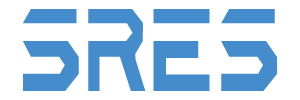Visual Model Editor & IGES File Import & Export
Projectiles are quickly created using the PRODAS model editor.
Designed and optimized for projectiles, it is much quicker and easier to use than a standard CAD package.
Drag and drop projectile assemblies or components from one projectile to another.
Trace a Bitmap
The optional module Projectile Tracing Tool will allow you to quickly build a model from a bitmap of a cross-section.
Click HERE for more information

DXF & IGES File Write!
PRODAS V3 can create IGES (V 4.0) & DXF Files for easy output to CAD Systems.
Logical Model Structure
Simple Elements are combined to describe the geometry of Components. Material properties are defined at the component level. A Material Reference Book is included to ease this process. Components are combined to make up Assemblies. Assemblies can be combined to form higher-level assemblies.
Mass Properties
Calculate weights, inertias, and CG from the model
Mass property results are stored in the projectile file for subsequent analysis.
Experimental data can be entered and “locked”. The system will use this data and calculate only the unknown values.
Properties are calculated before and after burnout of a rocket motor or fumer.



Aerodynamic Coefficient Prediction
Computes a complete set of aerodynamic force and moment coefficients!

Includes analysis capabilities for
- Spin, Fin or Drag Stabilized Shapes
- Computer Attack Angle & Roll Induced Coeffs for Finners
- Calculates Dynamic & Gyroscopic Stability
- Multiple Fin Groups
- Wrap Around Fins
- Grooved Body (Buttress)
- Flare/Conical Stabilized
- Spike Nose, “Stubby”
- Aeros up to Mach 8
Aerodynamic Stability Analysis
Keep them flying STRAIGHT

- Static Stability
- Dynamic Stability
- Gyroscopic Stability
- Coefficients under a variety of launch conditions.

Muzzle Exit / Dispersion
Estimate projectile dispersion from in-bore clearances and C.G. offset.
Perform Dispersion Sensitivity Analysis
Determine the Muzzle Exit Effect


4 & 6 DoF Fixed Plane Trajectory Simulation
- Trajectory Simulation
- Compute complex trajectory effects with either a 4 or 6-degree of freedom simulation. Trajectory files can be saved for cross-plotting or for use in the Armor Penetration Module.
- 4DOF and 6DOF Models
- Moving Platform option
- Rocket Motor Simulation
- Aerodynamic Asymmetries
- Winds
Ballistic Match
- Create Range vs. Quadrant Elevation tables and estimate the maximum range in minutes.
- With Ballistic Match, projectile performance parameters can be modified quickly to achieve a desired Drop vs. Range
- Ballistic Match runs a series of 4 DOF trajectories between 0 and 80 degrees elevation and saves impact points, impact conditions, angle of fall, and culmination ranges and altitudes.
- Ballistic Match automatically iterates the gun quadrant elevation, saving the designer tiresome iterations to make a bullet strike a target at a given range.
- The required quadrant elevations and key trajectory parameters for each range interval are saved for quick reference.
- Ballistic Match can be used alone, to display maximum range and quadrant elevation information, or it can be used in conjunction with the trajectory module to generate initial conditions.

Lot Acceptance Test (LAT) Simulation
A statistical simulation for estimating the long-term pass probability of Lot Acceptance Tests with various pass criteria.
- Use LAT to simulate dispersion tests before expending valuable test resources.
- Understand the impact of random variation on pass/fail probability.
- Adjust sample size and acceptance criteria to design an effective test and eliminate “false failures”

Inputs
- Select from three standard dispersion measurement criteria
- Sigma X-Sigma Y
- Mean Radius
- Extreme Spread
- Enter Sample Size and Acceptance Criteria
Current (or expected) Projectile Performance
Five thousand (5000) LATs are simulated, and individual results are accumulated. Mean dispersion, dispersion standard deviation, and probability of passing the test are outputs.
The standard deviation in mean point of impact (MPI) is also displayed to assist system engineers in assessing the statistical variability of a burst center point as a function of ammunition dispersion and the number of rounds fired in a burst.
Yaw Card
- Determine Cm and Cmq with no more than a tape measure, plumb bob, photographic paper, and a few 2×4.
- The Yaw Cards data reduction module is used to extract pitching moment coefficients (Cm),
- pitch damping moment coefficients (Cmq), and Magnus Moment (Cnp) coefficients from yaw
- card data.
- This includes data from spin-stabilized projectiles plus statically stable bullets with either low or moderate spin.
- Cm influences the gyroscopic stability factor (especially critical at launch) and dispersion sensitivity, while Cmq and Cnp affect the damping of the projectile yaw motion as it travels down range.

Series of target cards
- Record the total angle of attack & pointing vector change vs. distance from the muzzle
- Advantages:
- Simple technique
- Low-cost “instrumentation”

- Provides:
–Pitching moment, pitch damping, Magnus
moment, roll moment, roll decay moment
–Is yaw causing dispersion or only MPI shift?
- Drawbacks:
- Need sufficient yaw to allow observation (Yaw Inducer Needed?)
- Yaw card impact affects projectile motion

